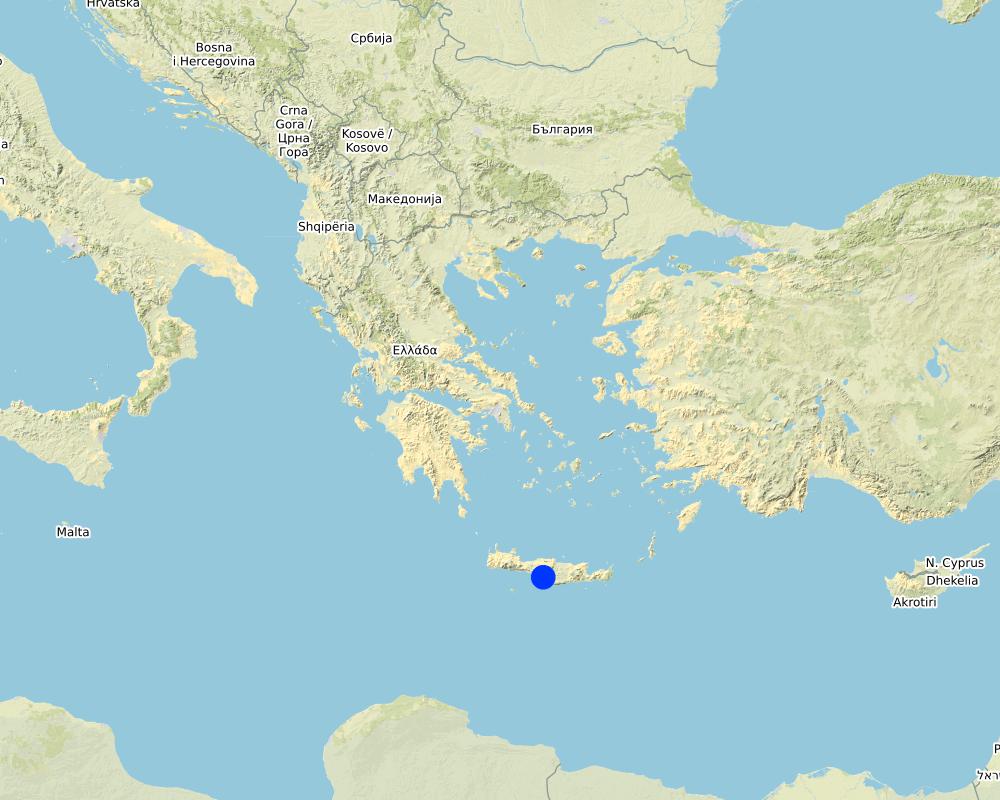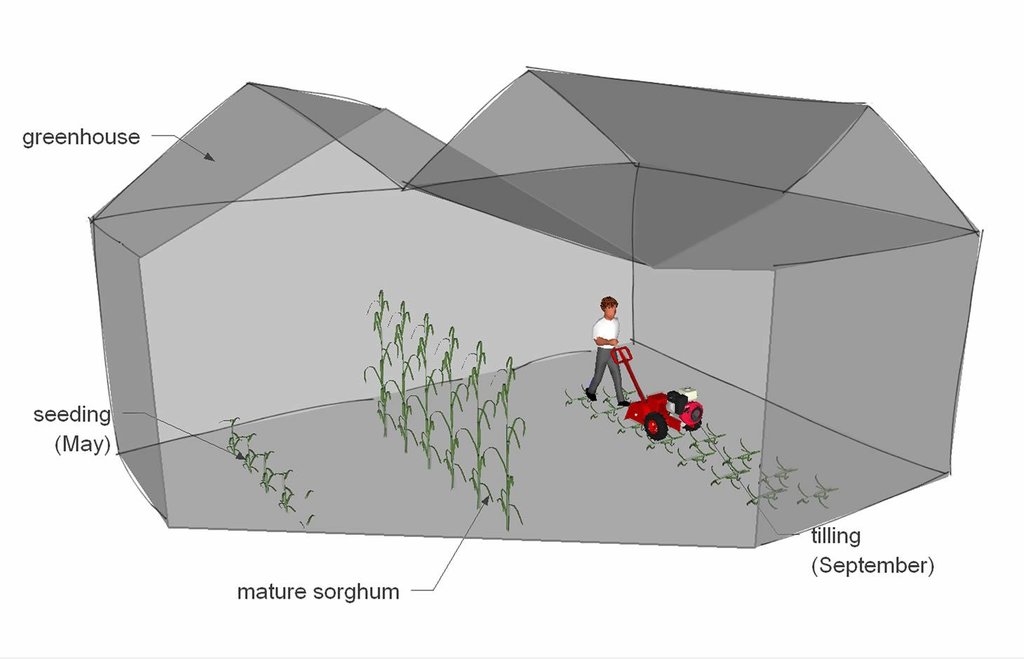Crop rotation for green manuring in greenhouse [希腊]
- 创建:
- 更新:
- 编制者: Ioanna Panagea
- 编辑者: –
- 审查者: Alexandra Gavilano, Fabian Ottiger, Rima Mekdaschi Studer
Aμειψισπορά για χλωρή λίπανση σε θερμοκήπιο
technologies_1246 - 希腊
查看章节
全部展开 全部收起1. 一般信息
1.2 参与该技术评估和文件编制的资源人员和机构的联系方式
SLM专业人员:
SLM专业人员:
有助于对技术进行记录/评估的项目名称(如相关)
Preventing and Remediating degradation of soils in Europe through Land Care (EU-RECARE )有助于对技术进行记录/评估的机构名称(如相关)
Technical University of Crete (Technical University of Crete) - 希腊1.3 关于使用通过WOCAT记录的数据的条件
编制者和关键资源人员接受有关使用通过WOCAT记录数据的条件。:
是
2. SLM技术的说明
2.1 技术简介
技术定义:
Crop rotation and use of green manure in sequence with sorghum and tomato
2.2 技术的详细说明
说明:
The angiosperm Sorghum vulgare is used in green house cultivations in coastal Timpaki, Crete, Greece, for green manuring through crop rotation with tomato plants. The crop rotation usually takes place every other summer when the green house is fallow. Sorghum plants are commonly used for grain, fibre and fodder, but this technology uses plants as soil conditioners.
Purpose of the Technology: The technology is applied as an effective agronomic measure for the increase of the productive capacity of soil, the reduction of pests (due to breaking or limiting pest cycles) and soil borne diseases and the mitigation of soil salinity. This technology mitigates and prevents soil degradation by improving the soil and subsoil structure through the deep root system of the plants (often >1 m) and increasing nutrient and organic matter availability through the incorporation of the plant biomass into the soil by tilling it under. Furthermore, the improved structure of the soil leads in higher infiltration rates, mitigates the salt accumulation in the root zone and combats soil salinity, one of the main soil degradation problems in the coastal zone. The increase of workload and the demand of irrigation water during the dry summer period constitute the main drawbacks of the SLM technology.
Establishment / maintenance activities and inputs: Initially, when the main crop (tomato- Solanum lycopersicum) is removed from the green house in June, about 7 kg of Sorghum seeds per 0.1 ha are sown and incorporated in the soil by ploughing at about 4-5 cm depth. Sorghum is drought- and heat-tolerant thus the irrigation needs are minimum and depend on the respective climatic conditions. As it is used for manuring and not fodder or fruit production, water stress conditions are favorable as the root system expands deeper in order to fulfill plant water needs thus improving the soil structure. In September, the farmer uses a branch grinder to fritter the Sorghum plants and then incorporates them in the soil by tillage.
Natural / human environment: The average annual precipitation in the area is 500 mm and the climate ranges between sub-humid Mediterranean and semi-arid. Average annual temperature is 18.5 degrees C with 6 months below 18 degrees C but above 5 degrees C, thus classifying the area as subtropical. In the location where the technology is applied, land is mostly privately owned and water rights can be public, cooperative or private. The financial means of the land user applying this technology are more or less on par with those of the rest of the community.
This Technology was documented within the scope of FP7 RECARE Project, funded grant agreement no 603498.
2.5 已应用该技术的、本评估所涵盖的国家/地区/地点
国家:
希腊
区域/州/省:
Heraklion
有关地点的进一步说明:
Timpaki
具体说明该技术的分布:
- 适用于特定场所/集中在较小区域
技术现场是否位于永久保护区?:
否
注释:
Total area covered by the SLM Technology is 0.006 km2.
Map
×2.6 实施日期
如果不知道确切的年份,请说明大概的日期:
- 10-50年前
2.7 技术介绍
详细说明该技术是如何引入的:
- 通过土地使用者的创新
注释(项目类型等):
The specific user has started using the crop rotation system for green manuring in his greenhouse in 2000. Since then he has experimented with a variety of plants in order to decide which works better for his case. He has been using sorghum for the past 8 years since it's the variety that suits better to the climatic conditions inside the greenhouse.
3. SLM技术的分类
3.2 应用该技术的当前土地利用类型

农田
- 一年一作
年作 - 具体指明作物:
- 谷类 - 高粱
- tomatoes
每年的生长季节数:
- 1
具体说明:
Longest growing period in days: 270Longest growing period from month to month: September to May
采用轮作制度了吗?:
是
注释:
Major cash crop: Tomato, Sorghum
Major land use problems (compiler’s opinion): The main problem in the region is the change in the groundwater quality, caused by the exploitation and seawater intrusion, resulting in soil salinisation through irrigation.The lack of sustainable freshwater resources for irrigation results in increased production risk and agricultural inputs. Also, soil quality is reduced due to the use of brackish water for irrigation and the intensive agricultural practices.
Major land use problems (land users’ perception): The reduction of soil fertility and productivity because of the over-exploitation of land and excessive use of pesticide.
3.4 供水
该技术所应用土地的供水:
- 充分灌溉
3.5 该技术所属的SLM组
- 轮作制度(轮作、休耕、轮垦)
3.6 包含该技术的可持续土地管理措施

农艺措施
- A2:有机质/土壤肥力
- A4:地表下处理
注释:
Main measures: agronomic measures
Type of agronomic measures: green manure, rotations / fallows
3.7 该技术强调的主要土地退化类型

化学性土壤退化
- Cs:盐化/碱化

生物性退化
- Bq:数量/生物量减少
注释:
Main type of degradation addressed: Bq: quantity / biomass decline
Secondary types of degradation addressed: Cs: salinisation / alkalinisation
Main causes of degradation: crop management (annual, perennial, tree/shrub) (Intensive mono-cultivation)
Secondary causes of degradation: disturbance of water cycle (infiltration / runoff) (Covering of land with greenhouses decreases natural leaching from precipitation.), over abstraction / excessive withdrawal of water (for irrigation, industry, etc.) (Overpumping.), land tenure (Short period land leasing), inputs and infrastructure: (roads, markets, distribution of water points, other, …) (Poor coverage of freshwater irrigation network.)
3.8 防止、减少或恢复土地退化
具体数量名该技术与土地退化有关的目标:
- 防止土地退化
- 减少土地退化
注释:
Main goals: mitigation / reduction of land degradation
Secondary goals: prevention of land degradation
4. 技术规范、实施活动、投入和成本
4.1 该技术的技术图纸
技术规范(与技术图纸相关):
Sorghum is seeded in May and incorporated in the ground in September.
Location: Timpaki. Heraklion, Crete
Date: 03/04/2015
Technical knowledge required for field staff / advisors: low
Technical knowledge required for land users: low
Main technical functions: improvement of subsoil structure (hardpan), increase in organic matter, increase in nutrient availability (supply, recycling,…)
Secondary technical functions: improvement of ground cover, improvement of topsoil structure (compaction), increase of infiltration, increase / maintain water stored in soil
Green manure
Material/ species: Sorghum vulgare
Quantity/ density: 70 kg/ha
Rotations / fallows
Material/ species: Solanum lycopersicum (tomato) - Sorghum vulgare (sorghum)
Remarks: Tomato between September-May, Sorghum between May-September
作者:
Daliakopoulos Ioannis
4.2 有关投入和成本计算的一般信息
其它/国家货币(具体说明):
Euro
如相关,注明美元与当地货币的汇率(例如1美元=79.9巴西雷亚尔):1美元=:
0.93
4.5 维护/经常性活动
| 活动 | 时间/频率 | |
|---|---|---|
| 1. | Seed sowing | May |
| 2. | Irrigation | 3-4 times in dry conditions |
| 3. | Reduce branch length with a branch grinder | September |
| 4. | Incorporation of Sorghum in the soil with a tiller | September |
4.6 维护/经常性活动所需要的费用和投入(每年)
| 对投入进行具体说明 | 单位 | 数量 | 单位成本 | 每项投入的总成本 | 土地使用者承担的成本% | |
|---|---|---|---|---|---|---|
| 劳动力 | Labour | ha | 1.0 | 132.0 | 132.0 | 100.0 |
| 设备 | Machine use | ha | 1.0 | 720.0 | 720.0 | 100.0 |
| 植物材料 | Seeds | ha | 1.0 | 75.0 | 75.0 | 100.0 |
| 其它 | Irrigation water | ha | 1.0 | 65.0 | 65.0 | 100.0 |
| 技术维护所需总成本 | 992.0 | |||||
| 技术维护总成本,美元 | 1066.67 | |||||
注释:
Machinery/ tools: tilling machine, branch grinder
4.7 影响成本的最重要因素
描述影响成本的最决定性因素:
The buying of the required machinery (The specific land user rents the required machinery)
5. 自然和人文环境
5.1 气候
年降雨量
- < 250毫米
- 251-500毫米
- 501-750毫米
- 751-1,000毫米
- 1,001-1,500毫米
- 1,501-2,000毫米
- 2,001-3,000毫米
- 3,001-4,000毫米
- > 4,000毫米
有关降雨的规范/注释:
About 400-500 mm annually
农业气候带
- 半湿润
- 半干旱
Thermal climate class: subtropics. 6 months below 18 degrees C but above 5 degrees C
5.2 地形
平均坡度:
- 水平(0-2%)
- 缓降(3-5%)
- 平缓(6-10%)
- 滚坡(11-15%)
- 崎岖(16-30%)
- 陡峭(31-60%)
- 非常陡峭(>60%)
地形:
- 高原/平原
- 山脊
- 山坡
- 山地斜坡
- 麓坡
- 谷底
垂直分布带:
- 0-100 m a.s.l.
- 101-500 m a.s.l.
- 501-1,000 m a.s.l.
- 1,001-1,500 m a.s.l.
- 1,501-2,000 m a.s.l.
- 2,001-2,500 m a.s.l.
- 2,501-3,000 m a.s.l.
- 3,001-4,000 m a.s.l.
- > 4,000 m a.s.l.
5.3 土壤
平均土层深度:
- 非常浅(0-20厘米)
- 浅(21-50厘米)
- 中等深度(51-80厘米)
- 深(81-120厘米)
- 非常深(> 120厘米)
土壤质地(表土):
- 中粒(壤土、粉土)
表土有机质:
- 高(>3%)
- 中(1-3%)
如有可能,附上完整的土壤描述或具体说明可用的信息,例如土壤类型、土壤酸碱度、阳离子交换能力、氮、盐度等。:
Soil texture is medium (Characterized mainly as sandy clay loam or clay loam)
Soil fertility is medium
Soil drainage/infiltration is medium
Soil water storage capacity is high
5.4 水资源可用性和质量
地下水位表:
5-50米
地表水的可用性:
中等
水质(未处理):
仅供农业使用(灌溉)
关于水质和水量的注释和进一步规范:
Water quality (untreated): good drinking water, for agricultural use only (irrigation) (Brackish irrigation water)
5.5 生物多样性
物种多样性:
- 低
5.6 应用该技术的土地使用者的特征
生产系统的市场定位:
- 商业/市场
非农收入:
- 收入的10-50%
相对财富水平:
- 平均水平
- 丰富
个人或集体:
- 个人/家庭
机械化水平:
- 手工作业
性别:
- 男人
说明土地使用者的其他有关特征:
Land users applying the Technology are mainly common / average land users
Population density: 10-50 persons/km2
Annual population growth: 1% - 2%
5.7 应用该技术的土地使用者使用的平均土地面积
- < 0.5 公顷
- 0.5-1 公顷
- 1-2 公顷
- 2-5公顷
- 5-15公顷
- 15-50公顷
- 50-100公顷
- 100-500公顷
- 500-1,000公顷
- 1,000-10,000公顷
- > 10,000公顷
这被认为是小规模、中规模还是大规模的(参照当地实际情况)?:
- 小规模的
5.8 土地所有权、土地使用权和水使用权
土地所有权:
- 个人,有命名
土地使用权:
- 租赁
- 个人
- Cooperative
用水权:
- 社区(有组织)
- 个人
- Cooperative
5.9 进入服务和基础设施的通道
健康:
- 贫瘠
- 适度的
- 好
教育:
- 贫瘠
- 适度的
- 好
技术援助:
- 贫瘠
- 适度的
- 好
就业(例如非农):
- 贫瘠
- 适度的
- 好
市场:
- 贫瘠
- 适度的
- 好
能源:
- 贫瘠
- 适度的
- 好
道路和交通:
- 贫瘠
- 适度的
- 好
饮用水和卫生设施:
- 贫瘠
- 适度的
- 好
金融服务:
- 贫瘠
- 适度的
- 好
6. 影响和结论性说明
6.1 该技术的现场影响
社会经济效应
生产
作物生产
注释/具体说明:
Due to increased soil organic matter
生产故障风险
注释/具体说明:
Because of the diseases control
水资源可用性和质量
灌溉用水需求
收入和成本
农业投入费用
注释/具体说明:
Due to reduced fertilizers
工作量
其它社会经济效应
Improved livelihoods and human well-being
社会文化影响
SLM/土地退化知识
生态影响
土壤
土壤水分
养分循环/补给
盐度
土壤有机物/地下C
生物多样性:植被、动物
生物量/地上C
害虫/疾病控制
6.3 技术对渐变气候以及与气候相关的极端情况/灾害的暴露和敏感性(土地使用者认为的极端情况/灾害)
渐变气候
渐变气候
| 季节 | 增加或减少 | 该技术是如何应对的? | |
|---|---|---|---|
| 年温度 | 增加 | 好 |
气候有关的极端情况(灾害)
气象灾害
| 该技术是如何应对的? | |
|---|---|
| 局地暴雨 | 好 |
气候灾害
| 该技术是如何应对的? | |
|---|---|
| 干旱 | 好 |
注释:
Various types of vegetation were tested in order to assess which is more tolerant to the high temperature conditions inside the greenhouse. Sorghum was chosen as the most tolerant and otherwise convenient cultivation.
6.4 成本效益分析
技术收益与技术建立成本相比如何(从土地使用者的角度看)?
短期回报:
轻度消极
长期回报:
积极
技术收益与技术维护成本/经常性成本相比如何(从土地使用者的角度看)?
短期回报:
轻度消极
长期回报:
非常积极
6.5 技术采用
如若可行,进行量化(住户数量和/或覆盖面积):
1
在所有采用这项技术的人当中,有多少人是自发的,即未获得任何物质奖励/付款?:
- 91-100%
注释:
100% of land user families have adopted the Technology without any external material support
1 land user families have adopted the Technology without any external material support
Comments on spontaneous adoption: Only one land user in the region applies the technology.
There is no trend towards spontaneous adoption of the Technology
6.7 该技术的优点/长处/机会
| 土地使用者眼中的长处/优势/机会 |
|---|
| Use of organic manuring decreases the required amounts of fertilizers and pesticides, therefore leading to a net decrease of costs for agricultural inputs. |
| 编制者或其他关键资源人员认为的长处/优势/机会 |
|---|
|
Use of organic manuring decreases the required amounts of fertilizers and pesticides, therefore leading to a healthier soil in a sustainable way. How can they be sustained / enhanced? The technology is self sustained. |
6.8 技术的弱点/缺点/风险及其克服方法
| 土地使用者认为的弱点/缺点/风险 | 如何克服它们? |
|---|---|
| The technology increases workload during a period where the greenhouse is otherwise inactive/fallow. |
| 编制者或其他关键资源人员认为的弱点/缺点/风险 | 如何克服它们? |
|---|---|
| Required machinery (branch grinder, tiller) are not used full-time so their purchase can't be easily justified. | Machinery can be leased/rented |
7. 参考和链接
7.1 信息的方法/来源
链接和模块
全部展开 全部收起链接
无链接
模块
无模块



